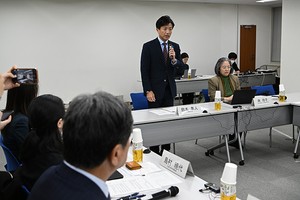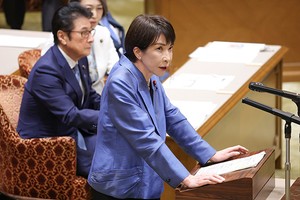By KUNIO OZAWA/ Staff Writer
January 29, 2025 at 17:05 JST
 A resident has her blood drawn for PFAS testing in Kibi-Chuo, Okayama Prefecture, on Nov. 25. (Kunio Ozawa)
A resident has her blood drawn for PFAS testing in Kibi-Chuo, Okayama Prefecture, on Nov. 25. (Kunio Ozawa)
KIBI-CHUO, Okayama Prefecture--More than 80 percent of Kibi-Chuo residents tested for cancer-causing organic fluorine compounds in their blood had levels exceeding U.S. guidelines, according to town officials.
The Kibi-Chuo town government on Jan. 28 released the results of blood tests conducted on 709 residents between November and December after perfluoroalkyl and polyfluoroalkyl substances, collectively known as PFAS, were detected in water from the town’s Enjo water purification plant.
The highest detected level was 743.1 nanograms per milliliter, with an average of 151.5 nanograms.
Japan does not have an official standard for PFAS levels in blood, but U.S. guidelines are set at 20 nanograms per milliliter. The town’s average was around 7.6 times the U.S. guidelines. More than 80 percent of those tested exceeded that level.
Takashi Yorifuji, professor of epidemiology and hygiene at Okayama University’s graduate school of medicine, who analyzed the data, noted that “PFAS levels were higher than those typically found in the general population.”
He said that it is difficult to interpret the results at this stage but emphasized the importance of follow-up surveys to monitor whether the levels decrease over time.
U.S. academic institutions set a guideline of 20 nanograms per milliliter for the total concentration of seven types of PFAS, considering this the threshold for potential health risks.
Kibi-Chuo town tested 709 people from the Enjo district, including residents and those who wished to be tested, aged 2 to 102, for these seven types of PFAS.
The data was grouped into two categories: 644 people aged 13 and older and 65 children aged 2 to 12.
The overall average PFAS level was 151.5 nanograms per milliliter.
Among those aged 13 and older, 88 percent had PFAS levels above 20 nanograms per milliliter.
Of these, 31.2 percent were between 20 and 99.9 nanograms, 24.7 percent were in the 100 to 199.9 range, and 1.2 percent had levels exceeding 500 nanograms.
For children aged 12 and younger, 81.5 percent had PFAS levels above 20 nanograms per milliliter.
Of these, 29.2 percent ranged from 20 to 99.9 nanograms, 35.4 percent were between 100 and 199.9 nanograms, and 1.5 percent had levels between 400 and 499.9 nanograms.
No children exceeded 500 nanograms, while 16.9 percent had levels between 10 and 19.9 nanograms.
TOWN: 'NO CLEAR HEALTH LINK FOUND'
The town government said that “even in cases of high PFAS levels, no clear link to health conditions has been identified at this point.”
“Predicting future health impacts is also difficult,” it continued.
The tests examined liver function, lipid levels, thyroid function and white blood cell counts.
Researchers from Okayama University, Kawasaki Medical School and other institutions will analyze the relationship between PFAS levels and health conditions.
The town plans to conduct another round of blood tests in fiscal 2029 for comparison.
“As expected from soil surveys, PFOA levels were high,” Yorifuji said. PFOA is one of the most common types of PFAS.
“I want to assess the relationship between PFAS levels and conditions such as lipid disorders,” he added.
The professor also explained that without further exposure, PFAS will gradually leave the body over time.
He emphasized the need for the town to continue monitoring residents’ health and for residents to undergo regular checkups and seek medical attention if they develop symptoms.
Kibi-Chuo Mayor Masanori Yamamoto said, “The levels are significantly higher than the U.S. guidelines.”
“The health effects are unclear, but it’s only natural for those affected to be deeply concerned,” the mayor said. “We will continue to support residents and do our best to ease their worries.”
RESIDENT BRIEFING IN FEBRUARY
The town government mailed the test results to residents on Jan. 27.
Public health nurses directly notified those with the highest detected levels and will continue to visit individuals with PFAS levels exceeding 500 nanograms to provide support.
A resident briefing will be held in the town on Feb. 16.
Additional tests are available for those who wish to be tested, and the town is currently conducting tests for 158 people who were unable to take part last year.
In September last year, the town’s expert committee publicly announced that the source of the PFAS contamination was likely spent activated carbon stored at a materials yard in the town.




















A peek through the music industry’s curtain at the producers who harnessed social media to help their idols go global.
A series based on diplomatic documents declassified by Japan’s Foreign Ministry
Here is a collection of first-hand accounts by “hibakusha” atomic bomb survivors.
Cooking experts, chefs and others involved in the field of food introduce their special recipes intertwined with their paths in life.
A series about Japanese-Americans and their memories of World War II